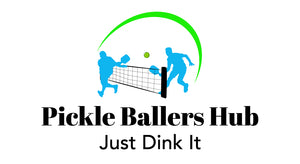Indoor Pickleballs vs Outdoor Pickleball Balls

Does using indoor or outdoor pickleball balls really make a difference? The short answer is yes, very much so.
First things first, what makes a good pickleball ball? Pickleball balls are unique and specifically designed. Both indoor and outdoor pickleball balls are hallow, plastic balls with holes drilled into them. A wiffle ball would be the closest comparison to imagine.
In order to be legally used in tournaments, or to properly play pickleball casually, pickleball balls have certain requirements: number of holes, type of material, size and weight. However, indoor and outdoor pickleball balls are not identical in these requirements, so using the proper one for your games will make a difference. Let’s compare.
Indoor Pickleballs vs Outdoor Pickleball Ball Design Comparison
- Indoor Pickleball Balls
- About 2.9” in diameter
- Softer plastic build
- Hallow
- Keeps pickleball balls lightweight
- Has 26 holes drilled into it
- Less holes, but larger holes than on the outdoor balls

- Outdoor Pickleball Balls
- About 2.9” in diameter
- Harder plastic build
- Designed to withstand rough play outdoors on concrete
- Hallow
- Keeps pickleball balls lightweight
- Has 40 holes drilled into it
- More holes, but smaller holes than on the indoor balls
- More holes eliminates the effects of wind A) slowing the ball and B) impacting its trajectory

- Both Types of Balls
- Both indoor and outdoor balls are made out of plastic
- The specific type of plastic can vary
- Most common plastics are:
- Low-Density Polyethylene (LDPE)
- High-Density Polyethylene (HDPE)
- Polypropylene (PP)
- Polyethylene Terephthalate (PET)
- Their plastic construction, along with the specifically drilled holes, gives pickleball balls their needed bounce
- Usually come in yellow, red, orange or green colors
- Has to be uniform color to be permitted in tournament play
Indoor Pickleballs vs Outdoor Pickleball Ball Hardness Comparison
Pickleball hardness is measured with the durometer hardness test. This is a test used to measure the hardness of materials, typically polymers (plastics). Materials are measured on a scale of 0-100, with 0 being the softest and 100 being the hardest.
The most commonly used plastics for pickleball balls fall amidst a range of hardness on this scale. Here are a few of the most popularly used materials and their corresponding hardness.
- Low-Density Polyethylene (LDPE) – 40-50
- High-Density Polyethylene (HDPE) – 60-70
- Polypropylene (PP) – 70-83
- Polyethylene Terephthalate (PET) – 85-95
The harder a pickleball ball material (so in this case, the higher the scale rating), the better it will bounce. Since indoor pickleball balls are softer than outdoor pickleball balls, you will find that the outdoor balls have better bounce.
Indoor Pickleballs vs Outdoor Pickleball Ball Weight Comparison
- Indoor Pickleballs
- Lighter than outdoor balls
- 0.8 oz
- Outdoor Pickleballs
- Heavier than indoor balls by a very slight margin
- 0.9 oz
Indoor Pickleballs vs Outdoor Pickleball Ball Price Comparison
Indoor and outdoor pickleball balls typically do not differ in price. They are available in all sorts of quantities; from 3 packs to 10 packs or more. As expected, the more balls that come in a pack, the higher the price.

Benefits of Indoor Pickleballs & Outdoor Pickleball Balls
- Indoor Pickleballs
- Designed to be easier to control
- Texture difference enables better ability to add more spin on shots
- Won’t crack or lose shape as easily as outdoor balls
- Longer lifespan than outdoor balls
- Outdoor Pickleballs
- Specific design with 40 holes eliminates nearly any effects from wind
- Harder plastic build provides more bounce than indoor balls
Drawbacks of Indoor Pickleballs & Outdoor Pickleball Balls
- Indoor Pickleballs
- Due to their design of 26 larger holes, they have more drag on their speed
- An equal amount of shot power will produce higher ball speeds for an outdoor ball than an indoor ball
- Outdoor Pickleballs
- Due to their harder design, and being used outdoors, they can crack or lose shape more easily
- This can happen after a few games or a few months depending on players’ style, court conditions and outdoor temperatures
- In general, they have shorter lifespans than indoor balls
Indoor Pickleballs vs Outdoor Pickleball Balls Chart
|
Material |
Softer plastic build |
Harder plastic build |
|
Weight |
~0.8 oz |
~0.9 oz |
|
Size (diameter) |
~2.9” |
~2.9” |
|
Number of Holes |
26 (larger sized holes) |
40 (smaller sized holes) |
|
Drag / Speed |
More drag, slower ball speed |
Less drag, faster ball speed |
|
Spin / Control |
More ability to control & add spin to shots |
Less ability to control & add spin to shots |
|
Durability |
More durable |
Less durable, prone to crack |
|
Lifespan |
Longer lifespan |
Shorter lifespan |
Best Indoor Pickleball Balls and Outdoor Pickleball Balls
While there are some more popular name brands that make indoor and outdoor pickleball balls, it will come down to your preference on which is best for you and your playstyle. At Pickle Ballers Hub we carry what we consider to be the best pickleball balls. We wouldn’t offer you anything our team doesn’t personally use.
If you're interested in shopping for outdoor pickleballs, click here! If you're looking for indoor pickleballs, click here!
We know that finding the perfect pickleball could be difficult with so many phenomenal options out there. If you're still unsure which pickleballs you want, shop our entire collection of pickleballs here!


